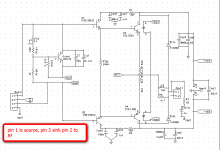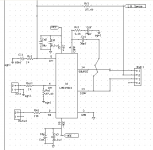Dear Ken,
No I have a hard time to obtain the Toshiba's here in the Netherlands.
In which way you didn't got them to run? They didn't conduct? Oscillations?
They are designed for home theatre receivers. I am kind of stubbornand I think I can't give up before I have them working
With kind regards,
Bas
Oscillations. I hope you're successful. If so, please tell me how you make them work.
Ken
Oscillations. I hope you're successful. If so, please tell me how you make them work.
Ken
Dear Ken,
Of course I will keep the forum updated. Did you try small capacitors from collector to base?
With kind regards,
Bas
and what were the peak currents from the 811, the drivers and the outputs?I haven't preformed a full power test yet. But just recorded .0024% Thd with my LME49811 driving my Allison output stage - no predrivers and 15032/33 as the drive transistors.
What was the load resistance?
The big problem that seems to be getting ignored here is what happens in the ealier stages when the output current demand increases.
If the output is 1Apk (8Vpk & 4W into 8r0) then the actual amp can be measured to find the earlier stage currents.
Now increase the output by 20%. What are the INCREASES in each of the earlier stages?
Try for +50%, +100%, +200%, +300%.
The earlier stages will pass much more current than simply applying the same factor as was used for the output current. It gets much worse as the output current approaches values required to drive reactive speakers with fast starting and fast stopping transient signals that are still with the clipping range of the amplifier's output.
The earlier stages will rapidly run into overload as the output current increases.
Dear,
I have to be agree with Andrew. I did today some more experiments with the LME49811 chip alone without drivers. And like every VAS the LME49811 doesn't like (heavy) loads. Above 1mA things get ugly, adding more capacitance things get more ugly. The LME49810 is a different beast though.
If you use the LME49811 you have to make sure it perform below 1mA all the time. The LME49810 on the other hand can easily deliver 20mA without rise in THD.
I don't say it won't work if you use the LME49811 without drivers, but I fear you don't get the best THD performance.
With kind regards,
Bas
I have to be agree with Andrew. I did today some more experiments with the LME49811 chip alone without drivers. And like every VAS the LME49811 doesn't like (heavy) loads. Above 1mA things get ugly, adding more capacitance things get more ugly. The LME49810 is a different beast though.
If you use the LME49811 you have to make sure it perform below 1mA all the time. The LME49810 on the other hand can easily deliver 20mA without rise in THD.
I don't say it won't work if you use the LME49811 without drivers, but I fear you don't get the best THD performance.
With kind regards,
Bas
that the chips are capable of giving.I don't say it won't work if you use the LME49811 without pre-drivers, but I fear you don't get the best sound quality
Dear Ken,
Of course I will keep the forum updated. Did you try small capacitors from collector to base?
With kind regards,
Bas
Bas,
Thanks for the suggestion, it worked great.
Ken
Bas,
Thanks for the suggestion, it worked great.
Ken
Dear Ken,
You have them running? Normally with faster pre driver transistors I put between 47p and 220p between collector and base to kill oscillation. I don't know the formula for the right value, I do it on the workbench with trial and error
With kind regards,
Bas
Dear Ken,
You have them running? Normally with faster pre driver transistors I put between 47p and 220p between collector and base to kill oscillation. I don't know the formula for the right value, I do it on the workbench with trial and error
With kind regards,
Bas
Bas,
Yes they are running. I started with 100pf and reduced that to 56pf. I haven't tried going any lower than 56pf. Works on my EF output configuration and my Allison output configuration.
Ken
Bas,
Yes they are running. I started with 100pf and reduced that to 56pf. I haven't tried going any lower than 56pf. Works on my EF output configuration and my Allison output configuration.
Ken
Dear Ken,
Would you like to share your schematics? I am curious to your design.
With kind regards,
Bas
Dear Ken,
Would you like to share your schematics? I am curious to your design.
With kind regards,
Bas
Bas,
Internet service is sketchy.. phone co. has crossed our wires... we'll see if this works.
First measured THD at low power with the 2sc4793 2sa1837 as drivers with 56pf btwn collector and base in the EF output (with Thermal Traks as output transistors) in lieu of the 15032/33's jumped way up lots harmonics 0.228THD.
Attached is schematic of the EF output stage.
More later.
Ken
Attachments
- Status
- This old topic is closed. If you want to reopen this topic, contact a moderator using the "Report Post" button.
- Home
- Amplifiers
- Chip Amps
- LME49810/STD03 parallel pairs

